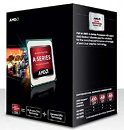- Joined
- Oct 9, 2007
- Messages
- 47,670 (7.43/day)
- Location
- Dublin, Ireland
| System Name | RBMK-1000 |
|---|---|
| Processor | AMD Ryzen 7 5700G |
| Motherboard | Gigabyte B550 AORUS Elite V2 |
| Cooling | DeepCool Gammax L240 V2 |
| Memory | 2x 16GB DDR4-3200 |
| Video Card(s) | Galax RTX 4070 Ti EX |
| Storage | Samsung 990 1TB |
| Display(s) | BenQ 1440p 60 Hz 27-inch |
| Case | Corsair Carbide 100R |
| Audio Device(s) | ASUS SupremeFX S1220A |
| Power Supply | Cooler Master MWE Gold 650W |
| Mouse | ASUS ROG Strix Impact |
| Keyboard | Gamdias Hermes E2 |
| Software | Windows 11 Pro |
AMD unveiled a new mid-range APU to take on Intel's Core i3 "Haswell" processors, the A10-7800 (model: AD7800YBI44JA). Based on the 28 nm "Kaveri" silicon, and built in the socket FM2+ package, this part differs from the A10-7850K in lacking an unlocked CPU base clock multiplier, and a rated TDP of just 65W (compared to the former's 95W). The A10-7800 features four x86-64 cores based on the "Steamroller" micro-architecture, spread across two modules, featuring 4 MB (2x 2 MB) of L2 cache; clocked at 3.50 GHz, with a TurboCore frequency of 3.90 GHz. Also featured is Radeon R7 Series integrated GPU featuring 512 GCN2 cores, with support for AMD Mantle and DirectX 11.2. Its uncore component features a dual-channel DDR3 integrated memory controller, with support for DDR3-1866 MHz, and a PCI-Express gen 3.0 root complex. It's expected to be priced between US $140 and $150.

View at TechPowerUp Main Site

View at TechPowerUp Main Site






